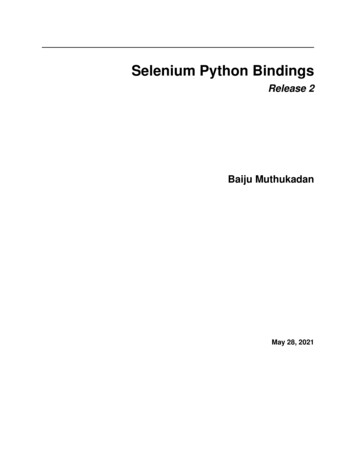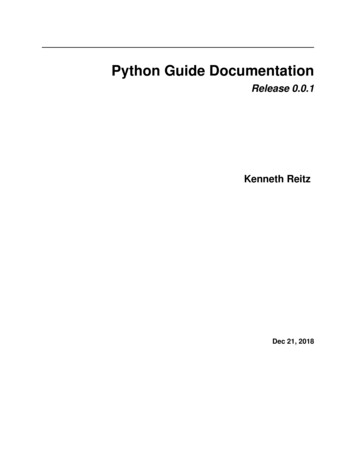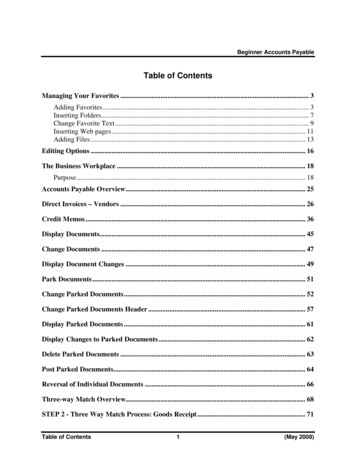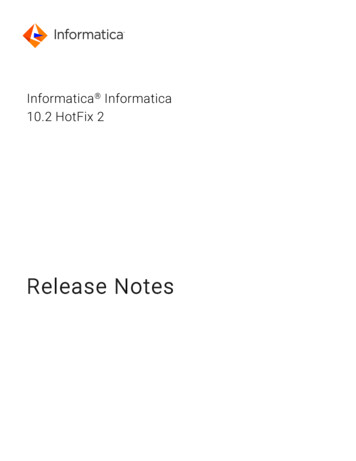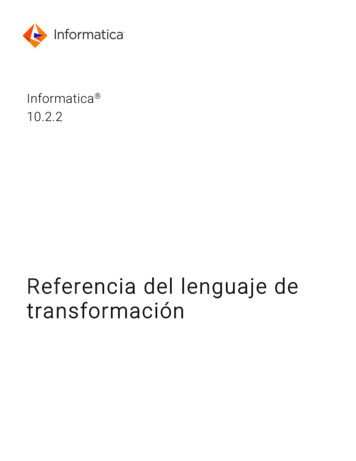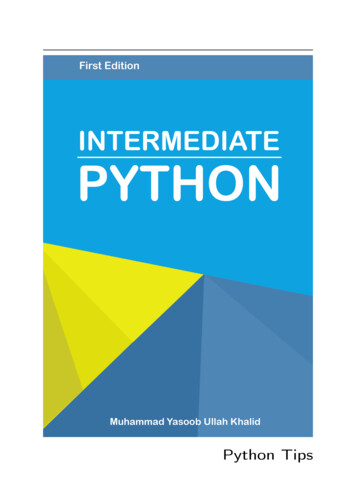
Transcription
Python Tips
Release 0.1Muhammad Yasoob Ullah KhalidSep 20, 2020
Contents1Preface22Author33Table of Contents3.1 *args and **kwargs . . .3.2 Debugging . . . . . . .3.3 Generators . . . . . . . .3.4 Map, Filter and Reduce3.5 set Data Structure . . .3.6 Ternary Operators . . .3.7 Decorators . . . . . . . .3.8 Global & Return . . . .3.9 Mutation . . . . . . . . .3.10 slots Magic . . . . .3.11 Virtual Environment . .3.12 Collections . . . . . . .3.13 Enumerate . . . . . . . .3.14 Zip and unzip . . . . . .3.15 Object introspection . .3.16 Comprehensions . . . .3.17 Exceptions . . . . . . . .3.18 Classes . . . . . . . . . .3.19 Lambdas . . . . . . . . .3.20 One-Liners . . . . . . .3.21 for/else . . . . . . . . .3.22 Python C extensions . .3.23 open Function . . . . . .3.24 Targeting Python 2 3 .3.25 Coroutines . . . . . . . .3.26 Function caching . . . 7i
3.27 Context Managers . . . . . . . . . . . . . . . . . . . . . . . . . . . . . . . 68ii
Python Tips, Release 0.1Note: You can sign up to my mailing list so that you remain in sync with any majorupdates to this book or my future projects!Contents1
CHAPTER 1PrefacePython is an amazing language with a strong and friendly community of programmers. However, there is a lack of documentation on what to learn after getting thebasics of Python down your throat. Through this book I aim to solve this problem. Iwould give you bits of information about some interesting topics which you can further explore.The topics which are discussed in this book open up your mind towards some nicecorners of Python language. This book is an outcome of my desire to have somethinglike this when I was beginning to learn Python.If you are a beginner, intermediate or even an advanced programmer there is something for you in this book.Please note that this book is not a tutorial and does not teach you Python. The topicsare not explained in depth, instead only the minimum required information is given.I am sure you are as excited as I am so let’s start!Note: This book is a continuous work in progress. If you find anything which you canfurther improve (I know you will find a lot of stuff) then kindly submit a pull request!2
CHAPTER 2AuthorI am Muhammad Yasoob Ullah Khalid. I have been programming extensively inPython for over 3 years now. I have been involved in a lot of Open Source projects. Iregularly blog about interesting Python topics over at my blog . In 2014 I also spoke atEuroPython which was held in Berlin. It is the biggest Python conference in Europe.If you have an interesting Internship opportunity for me then I would definitely liketo hear from you!3
CHAPTER 3Table of Contents3.1 *args and **kwargsI have come to see that most new python programmers have a hard time figuring outthe *args and **kwargs magic variables. So what are they ? First of all, let me tell youthat it is not necessary to write *args or **kwargs. Only the * (asterisk) is necessary.You could have also written *var and **vars. Writing *args and **kwargs is just aconvention. So now let’s take a look at *args first.3.1.1 Usage of *args*args and **kwargs are mostly used in function definitions. *args and **kwargs allowyou to pass an unspecified number of arguments to a function, so when writing thefunction definition, you do not need to know how many arguments will be passed toyour function. *args is used to send a non-keyworded variable length argument listto the function. Here’s an example to help you get a clear idea:def test var args(f arg, *argv):print("first normal arg:", f arg)for arg in argv:print("another arg through *argv:", arg)test var args('yasoob', 'python', 'eggs', 'test')This produces the following result:4
Python Tips, Release 0.1first normal arg: yasoobanother arg through *argv: pythonanother arg through *argv: eggsanother arg through *argv: testI hope this cleared away any confusion that you had. So now let’s talk about **kwargs3.1.2 Usage of **kwargs**kwargs allows you to pass keyworded variable length of arguments to a function.You should use **kwargs if you want to handle named arguments in a function. Hereis an example to get you going with it:def greet me(**kwargs):for key, value in kwargs.items():print("{0} {1}".format(key, value)) greet me(name "yasoob")name yasoobSo you can see how we handled a keyworded argument list in our function. This is justthe basics of **kwargs and you can see how useful it is. Now let’s talk about how youcan use *args and **kwargs to call a function with a list or dictionary of arguments.3.1.3 Using *args and **kwargs to call a functionSo here we will see how to call a function using *args and **kwargs. Just consider thatyou have this little function:def test args kwargs(arg1, arg2, arg3):print("arg1:", arg1)print("arg2:", arg2)print("arg3:", arg3)Now you can use *args or **kwargs to pass arguments to this little function. Here’show to do it:# first with *args args ("two", 3, 5) test args kwargs(*args)arg1: twoarg2: 3arg3: 5# now with **kwargs: kwargs {"arg3": 3, "arg2": "two", "arg1": 5} test args kwargs(**kwargs)(continues on next page)3.1. *args and **kwargs5
Python Tips, Release 0.1(continued from previous page)arg1: 5arg2: twoarg3: 3Order of using *args **kwargs and formal argsSo if you want to use all three of these in functions then the order issome func(fargs, *args, **kwargs)3.1.4 When to use them?It really depends on what your requirements are. The most common use case is whenmaking function decorators (discussed in another chapter). Moreover it can be used inmonkey patching as well. Monkey patching means modifying some code at runtime.Consider that you have a class with a function called get info which calls an API andreturns the response data. If we want to test it we can replace the API call with sometest data. For instance:import someclassdef get info(self, *args):return "Test data"someclass.get info get infoI am sure that you can think of some other use cases as well.3.2 DebuggingDebugging is also something which once mastered can greatly enhance your bug hunting skills. Most newcomers neglect the importance of the Python debugger (pdb). Inthis section I am going to tell you only a few important commands. You can learnmore about it from the official documentation.Running from the command lineYou can run a script from the command line using the Python debugger. Here is anexample: python -m pdb my script.pyIt would cause the debugger to stop the execution on the first statement it finds. Thisis helpful if your script is short. You can then inspect the variables and continue execution line-by-line.Running from inside a script3.2. Debugging6
Python Tips, Release 0.1You can set break points in the script itself so that you can inspect the variables andstuff at particular points. This is possible using the pdb.set trace() method. Here isan example:import pdbdef make bread():pdb.set trace()return "I don't have time"print(make bread())Try running the above script after saving it. You would enter the debugger as soon asyou run it. Now it’s time to learn some of the commands of the debugger.Commands: c: continue execution w: shows the context of the current line it is executing. a: print the argument list of the current function s: Execute the current line and stop at the first possible occasion. n: Continue execution until the next line in the current function is reached or itreturns.The difference between next and step is that step stops inside a called function, whilenext executes called functions at (nearly) full speed, only stopping at the next line inthe current function.These are just a few commands. pdb also supports post mortem. It is also a reallyhandy function. I would highly suggest you to look at the official documentation andlearn more about it.Note:It might seem unintuitive to use pdb.set trace() if you are new to this. Fortunately, if you are using Python 3.7 then you can simply use the breakpoint() [builtin ons.html#breakpoint). It automatically imports pdb and calls pdb.set trace().3.3 GeneratorsFirst lets understand iterators. According to Wikipedia, an iterator is an object thatenables a programmer to traverse a container, particularly lists. However, an iteratorperforms traversal and gives access to data elements in a container, but does not perform iteration. You might be confused so lets take it a bit slow. There are three partsnamely: Iterable3.3. Generators7
Python Tips, Release 0.1 Iterator IterationAll of these parts are linked to each other. We will discuss them one by one and latertalk about generators.3.3.1 IterableAn iterable is any object in Python which has an iter or a getitem methoddefined which returns an iterator or can take indexes (You can read more about themhere). In short an iterable is any object which can provide us with an iterator. Sowhat is an iterator?3.3.2 IteratorAn iterator is any object in Python which has a next (Python2) or next methoddefined. That’s it. That’s an iterator. Now let’s understand iteration.3.3.3 IterationIn simple words it is the process of taking an item from something e.g a list. Whenwe use a loop to loop over something it is called iteration. It is the name given to theprocess itself. Now as we have a basic understanding of these terms let’s understandgenerators.3.3.4 GeneratorsGenerators are iterators, but you can only iterate over them once. It’s because they donot store all the values in memory, they generate the values on the fly. You use themby iterating over them, either with a ‘for’ loop or by passing them to any functionor construct that iterates. Most of the time generators are implemented as functions.However, they do not return a value, they yield it. Here is a simple example of agenerator function:def generator function():for i in range(10):yield ifor item in generator function():print(item)# Output: 0# 1# 2(continues on next page)3.3. Generators8
Python Tips, Release 0.1(continued from previous page)#######3456789It is not really useful in this case. Generators are best for calculating large sets ofresults (particularly calculations involving loops themselves) where you don’t want toallocate the memory for all results at the same time. Many Standard Library functionsthat return lists in Python 2 have been modified to return generators in Python 3because generators require fewer resources.Here is an example generator which calculates fibonacci numbers:# generator versiondef fibon(n):a b 1for i in range(n):yield aa, b b, a bNow we can use it like this:for x in fibon(1000000):print(x)This way we would not have to worry about it using a lot of resources. However, ifwe would have implemented it like this:def fibon(n):a b 1result []for i in range(n):result.append(a)a, b b, a breturn resultIt would have used up all our resources while calculating a large input. We have discussed that we can iterate over generators only once but we haven’t tested it. Beforetesting it you need to know about one more built-in function of Python, next(). Itallows us to access the next element of a sequence. So let’s test out our understanding:def generator function():for i in range(3):yield igen generator function()(continues on next page)3.3. Generators9
Python Tips, Release 0.1(continued from previous page)print(next(gen))# Output: 0print(next(gen))# Output: 1print(next(gen))# Output: 2print(next(gen))# Output: Traceback (most recent call last):#File " stdin ", line 1, in module #StopIterationAs we can see that after yielding all the values next() caused a StopIteration error.Basically this error informs us that all the values have been yielded. You might bewondering why we don’t get this error when using a for loop? Well the answer issimple. The for loop automatically catches this error and stops calling next. Did youknow that a few built-in data types in Python also support iteration? Let’s check it out:my string "Yasoob"next(my string)# Output: Traceback (most recent call last):#File " stdin ", line 1, in module #TypeError: str object is not an iteratorWell that’s not what we expected. The error says that str is not an iterator. Well it’sright! It’s an iterable but not an iterator. This means that it supports iteration but wecan’t iterate over it directly. So how would we iterate over it? It’s time to learn aboutone more built-in function, iter. It returns an iterator object from an iterable. Whilean int isn’t an iterable, we can use it on string!int var 1779iter(int var)# Output: Traceback (most recent call last):# File " stdin ", line 1, in module # TypeError: 'int' object is not iterable# This is because int is not iterablemy string "Yasoob"my iter iter(my string)print(next(my iter))# Output: 'Y'Now that is much better. I am sure that you loved learning about generators. Do bearit in mind that you can fully grasp this concept only when you use it. Make sure thatyou follow this pattern and use generators whenever they make sense to you. Youwon’t be disappointed!3.3. Generators10
Python Tips, Release 0.13.4 Map, Filter and ReduceThese are three functions which facilitate a functional approach to programming. Wewill discuss them one by one and understand their use cases.3.4.1 MapMap applies a function to all the items in an input list. Here is the blueprint:Blueprintmap(function to apply, list of inputs)Most of the times we want to pass all the list elements to a function one-by-one andthen collect the output. For instance:items [1, 2, 3, 4, 5]squared []for i in items:squared.append(i**2)Map allows us to implement this in a much simpler and nicer way. Here you go:items [1, 2, 3, 4, 5]squared list(map(lambda x: x**2, items))Most of the times we use lambdas with map so I did the same. Instead of a list of inputswe can even have a list of functions!def multiply(x):return (x*x)def add(x):return (x x)funcs [multiply, add]for i in range(5):value list(map(lambda x: x(i), funcs))print(value)######Output:[0, 0][1, 2][4, 4][9, 6][16, 8]3.4. Map, Filter and Reduce11
Python Tips, Release 0.13.4.2 FilterAs the name suggests, filter creates a list of elements for which a function returnstrue. Here is a short and concise example:number list range(-5, 5)less than zero list(filter(lambda x: x 0, number list))print(less than zero)# Output: [-5, -4, -3, -2, -1]The filter resembles a for loop but it is a builtin function and faster.Note: If map & filter do not appear beautiful to you then you can read about list/dict/tuple comprehensions.3.4.3 ReduceReduce is a really useful function for performing some computation on a list and returning the result. It applies a rolling computation to sequential pairs of values in alist. For example, if you wanted to compute the product of a list of integers.So the normal way you might go about doing this task in python is using a basic forloop:product 1list [1, 2, 3, 4]for num in list:product product * num# product 24Now let’s try it with reduce:from functools import reduceproduct reduce((lambda x, y: x * y), [1, 2, 3, 4])# Output: 243.5 set Data Structureset is a really useful data structure. sets behave mostly like lists with the distinctionthat they can not contain duplicate values. It is really useful in a lot of cases. Forinstance you might want to check whether there are duplicates in a list or not. Youhave two options. The first one involves using a for loop. Something like this:3.5. set Data Structure12
Python Tips, Release 0.1some list ['a', 'b', 'c', 'b', 'd', 'm', 'n', 'n']duplicates []for value in some list:if some list.count(value) 1:if value not in s)# Output: ['b', 'n']But there is a simpler and more elegant solution involving sets. You can simply dosomething like this:some list ['a', 'b', 'c', 'b', 'd', 'm', 'n', 'n']duplicates set([x for x in some list if some list.count(x) 1])print(duplicates)# Output: set(['b', 'n'])Sets also have a few other methods. Below are some of them.IntersectionYou can intersect two sets. For instance:valid set(['yellow', 'red', 'blue', 'green', 'black'])input set set(['red', 'brown'])print(input set.intersection(valid))# Output: set(['red'])DifferenceYou can find the invalid values in the above example using the difference method. Forexample:valid set(['yellow', 'red', 'blue', 'green', 'black'])input set set(['red', 'brown'])print(input set.difference(valid))# Output: set(['brown'])You can also create sets using the new notation:a set {'red', 'blue', 'green'}print(type(a set))# Output: type 'set' There are a few other methods as well. I would recommend visiting the official documentation and giving it a quick read.3.5. set Data Structure13
Python Tips, Release 0.13.6 Ternary OperatorsTernary operators are more commonly known as conditional expressions in Python.These operators evaluate something based on a condition being true or not. Theybecame a part of Python in version 2.4Here is a blueprint and an example of using these conditional expressions.Blueprint:value if true if condition else value if falseExample:is nice Truestate "nice" if is nice else "not nice"It allows to quickly test a condition instead of a multiline if statement. Often times itcan be immensely helpful and can make your code compact but still maintainable.Another more obscure and not widely used example involves tuples. Here is somesample code:Blueprint:(if test is false, if test is true)[test]Example:nice Truepersonality ("mean", "nice")[nice]print("The cat is ", personality)# Output: The cat is niceThis works simply because True 1 and False 0, and so can be done with lists inaddition to tuples.The above example is not widely used and is generally disliked by Pythonistas for notbeing Pythonic. It is also easy to confuse where to put the true value and where to putthe false value in the tuple.Another reason to avoid using a tupled ternery is that it results in both elements of thetuple being evaluated, whereas the if-else ternary operator does not.Example:condition Trueprint(2 if condition else 1/0)#Output is 2print((1/0, 2)[condition])#ZeroDivisionError is raised3.6. Ternary Operators14
Python Tips, Release 0.1This happens because with the tupled ternary technique, the tuple is first built, thenan index is found. For the if-else ternary operator, it follows the normal if-else logictree. Thus, if one case could raise an exception based on the condition, or if either caseis a computation-heavy method, using tuples is best avoided.ShortHand TernaryIn python there is also the shorthand ternary tag which is a shorter version of thenormal ternary operator you have seen above.Syntax was introduced in Python 2.5 and can be used in python 2.5 or greater.Example True or "Some"True False or "Some"'Some'The first statement (True or “Some”) will return True and the second statement (False or“Some”) will return Some.This is helpful in case where you quickly want to check for the output of a functionand give a useful message if the output is empty: output None msg output or "No data returned" print(msg)No data returnedOr as a simple way to define function parameters with dynamic default values: def my function(real name, optional display name None): optional display name optional display name or real name print(optional display name) my function("John")John my function("Mike", "anonymous123")anonymous1233.7 DecoratorsDecorators are a significant part of Python. In simple words: they are functions whichmodify the functionality of other functions. They help to make our code shorter andmore Pythonic. Most beginners do not know where to use them so I am going to sharesome areas where decorators can make your code more concise.First, let’s discuss how to write your own decorator.3.7. Decorators15
Python Tips, Release 0.1It is perhaps one of the most difficult concepts to grasp. We will take it one step at atime so that you can fully understand it.3.7.1 Everything in Python is an object:First of all let’s understand functions in Python:def hi(name "yasoob"):return "hi " nameprint(hi())# output: 'hi yasoob'# We can even assign a function to a variable likegreet hi# We are not using parentheses here because we are not calling the function hi# instead we are just putting it into the greet variable. Let's try to run thisprint(greet())# output: 'hi yasoob'# Let's see what happens if we delete the old hi function!del hiprint(hi())#outputs: NameErrorprint(greet())#outputs: 'hi yasoob'3.7.2 Defining functions within functions:So those are the basics when it comes to functions. Let’s take your knowledge one stepfurther. In Python we can define functions inside other functions:def hi(name "yasoob"):print("now you are inside the hi() function")def greet():return "now you are in the greet() function"def welcome():return "now you are in the welcome() function"print(greet())print(welcome())print("now you are back in the hi() function")(continues on next page)3.7. Decorators16
Python Tips, Release 0.1(continued from previous areareinside the hi() functionin the greet() functionin the welcome() functionback in the hi() function# This shows that whenever you call hi(), greet() and welcome()# are also called. However the greet() and welcome() functions# are not available outside the hi() function e.g:greet()#outputs: NameError: name 'greet' is not definedSo now we know that we can define functions in other functions. In other words: wecan make nested functions. Now you need to learn one more thing, that functions canreturn functions too.3.7.3 Returning functions from within functions:It is not necessary to execute a function within another function, we can return it as anoutput as well:def hi(name "yasoob"):def greet():return "now you are in the greet() function"def welcome():return "now you are in the welcome() function"if name "yasoob":return greetelse:return welcomea hi()print(a)#outputs: function greet at 0x7f2143c01500 #This clearly shows that a now points to the greet() function in hi()#Now try thisprint(a())#outputs: now you are in the greet() functionJust take a look at the code again. In the if/else clause we are returning greet andwelcome, not greet() and welcome(). Why is that? It’s because when you put a pair ofparentheses after it, the function gets executed; whereas if you don’t put parenthesisafter it, then it can be passed around and can be assigned to other variables without3.7. Decorators17
Python Tips, Release 0.1executing it. Did you get it? Let me explain it in a little bit more detail. When wewrite a hi(), hi() gets executed and because the name is yasoob by default, thefunction greet is returned. If we change the statement to a hi(name "ali") thenthe welcome function will be returned. We can also do print hi()() which outputs nowyou are in the greet() function.3.7.4 Giving a function as an argument to another function:def hi():return "hi yasoob!"def doSomethingBeforeHi(func):print("I am doing some boring work before executing :I am doing some boring work before executing hi()#hi yasoob!Now you have all the required knowledge to learn what decorators really are. Decorators let you execute code before and after a function.3.7.5 Writing your first decorator:In the last example we actually made a decorator! Let’s modify the previous decoratorand make a little bit more usable program:def a new decorator(a func):def wrapTheFunction():print("I am doing some boring work before executing a func()")a func()print("I am doing some boring work after executing a func()")return wrapTheFunctiondef a function requiring decoration():print("I am the function which needs some decoration to remove my foul smell")a function requiring decoration()#outputs: "I am the function which needs some decoration to remove my foul smell"a function requiring decoration a new decorator(a function requiring decoration)#now a function requiring decoration is wrapped by wrapTheFunction()(continues on next page)3.7. Decorators18
Python Tips, Release 0.1(continued from previous page)a function requiring decoration()#outputs:I am doing some boring work before executing a func()#I am the function which needs some decoration to remove my foul smell#I am doing some boring work after executing a func()Did you get it? We just applied the previously learned principles. This is exactly whatthe decorators do in Python! They wrap a function and modify its behaviour in oneway or another. Now you might be wondering why we did not use the @ anywherein our code? That is just a short way of making up a decorated function. Here is howwe could have run the previous code sample using @.@a new decoratordef a function requiring decoration():"""Hey you! Decorate me!"""print("I am the function which needs some decoration to ""remove my foul smell")a function requiring decoration()#outputs: I am doing some boring work before executing a func()#I am the function which needs some decoration to remove my foul smell#I am doing some boring work after executing a func()#the @a new decorator is just a short way of saying:a function requiring decoration a new decorator(a function requiring decoration)I hope you now have a basic understanding of how decorators work in Python. Nowthere is one problem with our code. If we run:print(a function requiring decoration. name )# Output: wrapTheFunctionThat’s not what we expected! Its name is “a function requiring decoration”. Well,our function was replaced by wrapTheFunction. It overrode the name and docstringof our function. Luckily, Python provides us a simple function to solve this problemand that is functools.wraps. Let’s modify our previous example to use functools.wraps:from functools import wrapsdef a new decorator(a func):@wraps(a func)def wrapTheFunction():print("I am doing some boring work before executing a func()")a func()print("I am doing some boring work after executing a func()")return wrapTheFunction@a new decoratordef a function requiring decoration():(continues on next page)3.7. Decorators19
Python Tips, Release 0.1(continued from previous page)"""Hey yo! Decorate me!"""print("I am the function which needs some decoration to ""remove my foul smell")print(a function requiring decoration. name )# Output: a function requiring decorationNow that is much better. Let’s move on and learn some use-cases of decorators.Blueprint:from functools import wrapsdef decorator name(f):@wraps(f)def decorated(*args, **kwargs):if not can run:return "Function will not run"return f(*args, **kwargs)return decorated@decorator namedef func():return("Function is running")can run Trueprint(func())# Output: Function is runningcan run Falseprint(func())# Output: Function will not runNote: @wraps takes a function to be decorated and adds the functionality of copyingover the function name, docstring, arguments list, etc. This allows us to access thepre-decorated function’s properties in the decorator.Use-cases:Now let’s take a look at the areas where decorators really shine and their usage makessomething really easy to manage.AuthorizationDecorators can help to check whether someone is authorized to use an endpoint in aweb application. They are extensively used in Flask web framework and Django. Hereis an example to employ decorator based authentication:Example :3.7. Decorators20
Python Tips, Release 0.1from functools import wrapsdef requires auth(f):@wraps(f)def decorated(*args, **kwargs):auth request.authorizationif not auth or not check auth(auth.username, auth.password):authenticate()return f(*args, **kwargs)return decoratedLoggingLogging is another area where the decorators shine. Here is an example:from functools import wrapsdef logit(func):@wraps(func)def with logging(*args, **kwargs):print(func. name " was called")return func(*args, **kwargs)return with logging@logitdef addition func(x):"""Do some math."""return x xresult addition func(4)# Output: addition func was calledI am sure you are already thinking about some clever uses of decorators.3.7.6 Decorators with ArgumentsCome to think of it, isn’t @wraps also a decorator? But, it takes an argument like anynormal function can do. So, why can’t we do that too?This is because when you use the @my decorator syntax, you are applying a wrapperfunction with a single function as a parameter. Remember, everything in Python is anobject, and this includes functions! With that in mind, we can write a function thatreturns a wrapper function.3.7. Decorators21
Python Tips, Release 0.1Nesting a Decorator Within a FunctionLet’s go back to our logging example, and create a wrapper which lets us specify alogfile to output to.from functools import wrapsdef logit(logfile 'out.log'):def logging decorator(func):@wraps(func)def wrapped function(*args, **kwargs):log string func. name " was called"print(log string)# Open the logfile and appendwith open(logfile, 'a') as opened file:# Now we log to t
ing skills. Most newcomers neglect the importance of the Python debugger (pdb). In this section I am going to tell you only a few important commands. You can learn more about it from the official documentation. Running from the command line You can run a script from the command line using the Python debug
